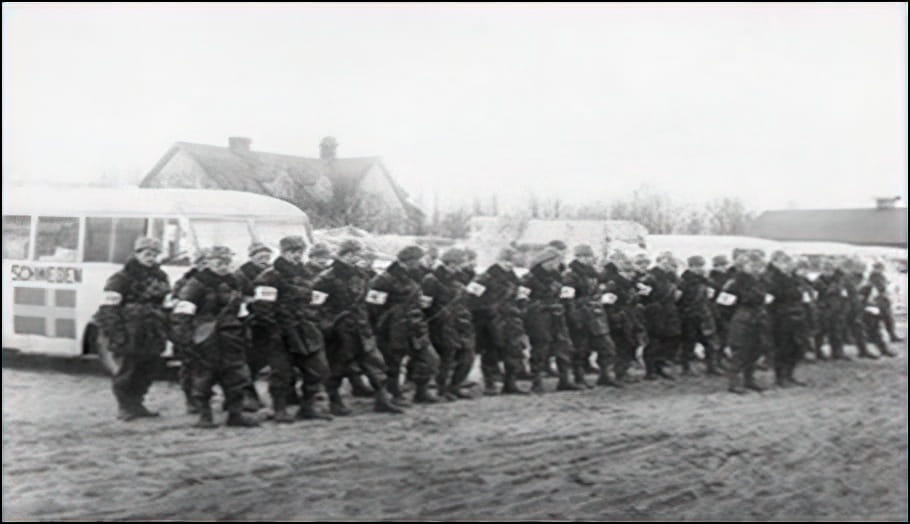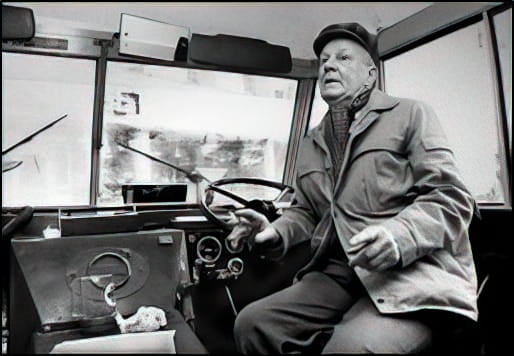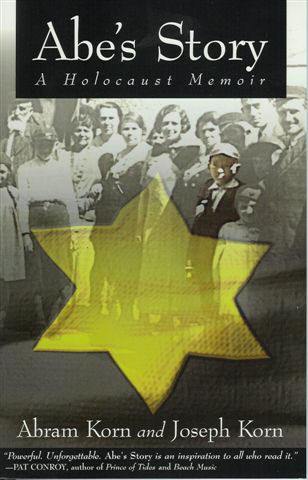Stig Svensson was a volunteer driver on one of the White Red Cross Buses
“I’ll never forget what I’ve seen”, he said in a 1992 interview.

< Gift #9- Erik Viggo Ringman | Gift #6 – Dorothea Sternheim >
Gift #10 – Stig Svensson and the Unheralded 300 Volunteers
More than 300 volunteers were needed to drive and staff the White Buses into Nazi Germany as the war was closing in on all sides[i].
Since Denmark and Norway were part of the war, Sweden’s neutrality and non-belligerent status combined to make this almost utopian dream a reality.
Just weeks before the German surrender on May 7, 1945, ordinary soldiers and civilians responded to the call for a secret mission to foray into the unknown.
These acts of heroism provide a lasting example of putting others before self.
The mission required a major logistical effort to coordinate 36 buses converted to mobile hospital units accompanied by 19 trucks, 14 motorcycles and cars, 7 motorcycles, a tow truck, field kitchen with food, and gasoline.
As a young citizen, Stig Svensson was a volunteer driver on one of the White Red Cross Buses (not the one in the picture). “I’ll never forget what I’ve seen”, he said in a 1992 interview.

This same sentiment comes from Sven Frykmann, a White Bus driver with vivid memories of those days, this mission and the people he met and helped.
“They were all very grateful and happy.
I think all of us who have had the privilege of helping these poor people in Germany have experienced such overwhelming gratitude that it is enough for the rest of our lives.”[i]
Driving these distances created its own miniature snapshots of the war.
Axel Molin remembers that as a driver “… on our way to Schömberg the activity in the air was very high and we were overflown many times by Allied fighter planes, that did not attack us.
Along the autobahn there were a lot of damaged cars and severely injured people.
In some places where chaos reigned, we simply could not just drive past with our white bus with Red Cross markings, but had to stop and give first aid. In some cases, the damage was enormous.” [ii]
Conclusion
Peter Tennant served as a spy for the British Special Operations Executive in Stockholm where he developed relationships with people from all walks of life and of various loyalties during the war.
From these on-the-ground perspectives, he concluded that: “the Swedish humanitarian efforts during and after the war did much to remove the dishonor the country had got during its acrobatic exercises in neutrality policy.”[iii]
At a policy or diplomatic level, some may debate this conclusion; from a humanitarian perspective, more than 15,000 people would say:
‘Thank you for the Gift of Life’
[1] Roger A. Ritvo is Distinguished Professor Emeritus at Auburn University Montgomery and Lecturer, University of Colorado Denver. The authors acknowledge Auburn University Montgomery’s partial support for this project.
Please send all correspondence related to this article to rritvo@yahoo.com.
[1] Allison Stone [1] Caitlyn P. Traffanstedt serves as the Performance Improvement (PI) Analyst at East Alabama Medical Center and a graduate student at Auburn University Montgomery.
[i] https://transportationhistory.org/2017/03/15/today-in-transportation-history-march-15-1945-a-wwi-rescue-mission/
[i] https://wikimili.com/en/White_Buses
[ii] https://wikimili.com/en/White_Buses
[iii] https://military-history.fandom.com/wiki/White_Buses#Transports_start
Accessed February 4, 2022.
https://military-history.fandom.com/wiki/Peter_Tennant?action=edit&redlink=1





